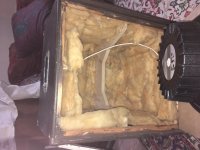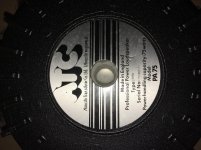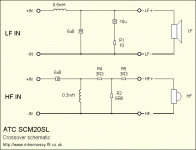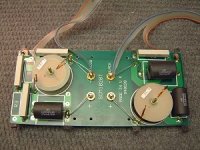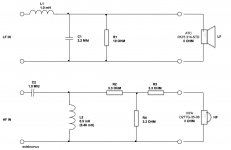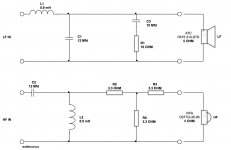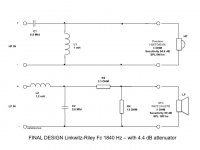I have a pair of ATC PA 314-STD 12" Drivers in cabinets which I have had for years. They are in good shape.
Now I want to make them into a more useful set of studio monitors by adding a tweeter into the cabinet.
I am thinking of using a Vifa D27TG-35-06 as the tweeter.
Does anyone have a basic two way crossover design or better know where I can source one.
Other data:
The cabinet is currently an infinite baffle with volume 0.814 m3. I may add a Helmholz port at the same time as fitting the tweeter
From the data on the PA 314-STD a good crossover frequency i would guess would be around 1.5 to 1.6kHz.
Now I want to make them into a more useful set of studio monitors by adding a tweeter into the cabinet.
I am thinking of using a Vifa D27TG-35-06 as the tweeter.
Does anyone have a basic two way crossover design or better know where I can source one.
Other data:
The cabinet is currently an infinite baffle with volume 0.814 m3. I may add a Helmholz port at the same time as fitting the tweeter
From the data on the PA 314-STD a good crossover frequency i would guess would be around 1.5 to 1.6kHz.
I have a pair of ATC PA 314-STD 12" Drivers in cabinets which I have had for years. They are in good shape.
Now I want to make them into a more useful set of studio monitors by adding a tweeter into the cabinet.
I am thinking of using a Vifa D27TG-35-06 as the tweeter.
Does anyone have a basic two way crossover design or better know where I can source one.
Other data:
The cabinet is currently an infinite baffle with volume 0.814 m3. I may add a Helmholz port at the same time as fitting the tweeter
From the data on the PA 314-STD a good crossover frequency i would guess would be around 1.5 to 1.6kHz.
0.814 m³....are you serious? That's 814 liters....
Adding only a tweeter will not bring you anything close to a studio monitor.
Start with a high quality midrange, that's what matters most.
Good bass and treble drivers come next.
Check ATC studio monitors; their hallmark is the 3 inch midrange dome covering the most important presence range (~400 Hz - 3k8).
These midrange domes are not available for DIY, but an interesting alternative is the 3 inch Volt midrange dome which is of the same pedigree.
A good quality tweeter is not difficult to find.
Please note that ATC studio monitors are active systems; trying to build a passive three-way will not be easy.
Crossing a 12” pa sub driver will always give you compromises in a 2way.
ATC PA 314-STD is a bass driver, not a sub.
Hi,
Perhaps I read this drivers specs wrong, but it looks to me that your 12" has an efficiency of around 99db!
All the ts parameters indicate that this is a dedicated mid range device with very limited bass output ( I can understand the need to put it into a gargantuan sized IB cabinet to eek-out a modicum of bass response ).
You might want to consider using a Fane TPL150H for the top-end ( since it's been well received for its sound-quality and a highish efficiency ).

Perhaps I read this drivers specs wrong, but it looks to me that your 12" has an efficiency of around 99db!
All the ts parameters indicate that this is a dedicated mid range device with very limited bass output ( I can understand the need to put it into a gargantuan sized IB cabinet to eek-out a modicum of bass response ).
You might want to consider using a Fane TPL150H for the top-end ( since it's been well received for its sound-quality and a highish efficiency ).
Attachments
Thanks for your answers.
First to Pieter.
On the cabinet. I was missing a zero. To to give the actual inside dimensions 0.345mm x 0.445mm x 0.530mm so it is actually 0.0814m3.
Here is a picture.
The cabinet was originally built by ATC their factory and intended as a PA set-up for mid range voice.
First to Pieter.
On the cabinet. I was missing a zero. To to give the actual inside dimensions 0.345mm x 0.445mm x 0.530mm so it is actually 0.0814m3.
Here is a picture.
The cabinet was originally built by ATC their factory and intended as a PA set-up for mid range voice.
Attachments
Again to Pieter
Maybe studio monitor is ambitious and I have looked at the active types. But I am looking to make the best reuse of what I have. In case I put a midrange driver in the set up I will have to put it a separate cabinet. So I am really looking for a compromise design and 2 way if possible. From your reply I should be looking at a mid range with some top. For my use - I am a musician and I like the presence of these speakers. But in he case I want to do some serious mix down I will use another smaller set-up.
Maybe studio monitor is ambitious and I have looked at the active types. But I am looking to make the best reuse of what I have. In case I put a midrange driver in the set up I will have to put it a separate cabinet. So I am really looking for a compromise design and 2 way if possible. From your reply I should be looking at a mid range with some top. For my use - I am a musician and I like the presence of these speakers. But in he case I want to do some serious mix down I will use another smaller set-up.
To Earl
Thanks for your spec sheet.
In your pdf I think it is the PA75 314 STD.
Again a picture.
These were the industry standard for professional audio. These STD units are mid range not bass so normally built into a large closed cabinet.
Also the 75W power rating on the backplate is nominal. They handle 150 - 300W as on the spec sheet.
They were one of the highest efficiency speakers at the time owing the way the coils are flat wound with very little gap to the magnet. So maybe your figures are correct.
I will keep looking to see what matches these at the higher end
Thanks for your spec sheet.
In your pdf I think it is the PA75 314 STD.
Again a picture.
These were the industry standard for professional audio. These STD units are mid range not bass so normally built into a large closed cabinet.
Also the 75W power rating on the backplate is nominal. They handle 150 - 300W as on the spec sheet.
They were one of the highest efficiency speakers at the time owing the way the coils are flat wound with very little gap to the magnet. So maybe your figures are correct.
I will keep looking to see what matches these at the higher end
Attachments
So I did a bit a research and the mid range driver proposed will be in the order GBP400 per speaker. So going back to my original idea of making a crossover I found this design on the web for the ATC scm20sl with Crossover 2.8 kHz
Attachments
Now taking the ATC scm20sl crossover design I have copied the attenuator T section which normalizes the different driver impedances then modifying the LC values to move the crossover from 2800 Hz to something around 1600 Hz I get the following design.
Is there anyone out there that can sanity check my crossover design? It is a long time since I have done a a design of a 1st order LC filters.
Any comments welcome.
Is there anyone out there that can sanity check my crossover design? It is a long time since I have done a a design of a 1st order LC filters.
Any comments welcome.
Attachments
Thanks Earl,
As a starter I am mimic. So - in the case of the copied network - capacitors are labelled "ATC Supersound" - they are from the Ansar CPA range. The coils are air-cored and use very thick wire. The resistors are standard 5% high-powered ceramic wirewounds.
I can source all these from Speaker Repair, Speaker Kits, Loudspeaker Repair, Kits and Drive Units, Subwoofer Amplifier Kit
But it looks like have more research to do about matched sensitivities.

As a starter I am mimic. So - in the case of the copied network - capacitors are labelled "ATC Supersound" - they are from the Ansar CPA range. The coils are air-cored and use very thick wire. The resistors are standard 5% high-powered ceramic wirewounds.
I can source all these from Speaker Repair, Speaker Kits, Loudspeaker Repair, Kits and Drive Units, Subwoofer Amplifier Kit
But it looks like have more research to do about matched sensitivities.
Second iteration design.
To follow the logic of the ATC circuit: The LOW path is a simple 12dB/octave LC filter, with an RC impedance-correcting network in parallel with the drive unit. For the HIGH path, a similar LC filter is followed by a resistive T-section attenuator to bring the tweeter level down to match the woofer. I may leave that out based on comments above
I am checking my LC values using Linkwitz-Riley 2nd order equations.
Again work in progress so any comments are to the good.
To follow the logic of the ATC circuit: The LOW path is a simple 12dB/octave LC filter, with an RC impedance-correcting network in parallel with the drive unit. For the HIGH path, a similar LC filter is followed by a resistive T-section attenuator to bring the tweeter level down to match the woofer. I may leave that out based on comments above
I am checking my LC values using Linkwitz-Riley 2nd order equations.
Again work in progress so any comments are to the good.
Attachments
Ultimately, one must design the network around the driver having the lowest sensitivity ( which is the tweeter in your case ).
There's no mystery here, a passive High-Pass filter will not magically turn a 90db tweeter into a 99db tweeter.
You're best off ( IMHO ) to split the difference in sensitivity and use a 93-95db tweeter all the while using a large value coil on the woofer ( to give some BSC & lose some of the extra midrange output ).
The larger the size of that coil, the lower the woofers overall functional sensitivity will end up ( & that'll help it match-up to the tweeter ) .
The affordable Peerless H26TG45-06 fits the bill for sensitivity ( & sounds quite respectable in the EAW products that I've heard it used in > JF50 ) .

There's no mystery here, a passive High-Pass filter will not magically turn a 90db tweeter into a 99db tweeter.
You're best off ( IMHO ) to split the difference in sensitivity and use a 93-95db tweeter all the while using a large value coil on the woofer ( to give some BSC & lose some of the extra midrange output ).
The larger the size of that coil, the lower the woofers overall functional sensitivity will end up ( & that'll help it match-up to the tweeter ) .
The affordable Peerless H26TG45-06 fits the bill for sensitivity ( & sounds quite respectable in the EAW products that I've heard it used in > JF50 ) .
Last edited:
This a summary of my design decisions - any comments welcome:
- Use Peerless Tweeter – it has the best efficiency available at nearly 95dB. You will never find another driver that will match the 99dB of the ATC even if horn loaded to increase SPL
- Start from scratch with LP/HP design
- Remove T attenuator network from Tweeter circuit cf. ATC SCM 20 SL design – it’s not right for these drivers
A 4.4 dB attenuator theoretically is needed on ATC Woofer to match sensitivities but I will try without it first.
- If needed I will use a basic L pad & not copy the T section. I don’t know what the extra Resistor in the T network does and how it affects the output impedance of the filter
Remove RC impedance-correcting network cf. ATC SCM 20 SL design – I have no idea what ATC driver impedance is anyway
- Butterworth 2nd order – is best approximation to flat response for both Amplitude & Power – it looks like the ATC SCM 20 SL circuit. It will probably need polarity reversal of drivers to cancel phase.
- Linkwitz-Riley 2nd order has power dip at Fc. Plus point is that L-R is phase neutral
- Conclusion – Butterworth is better if Power/Presence is needed.L-R is better for spatial phase accuracy i.e. You won’t get so much reinforcement or cancellations of some frequencies across the sound space.
- I could try both but the dilemma is that it will cost £25 more to experiment
- ATC driver recommends Fc up to 1500 Hz but has usable range up to 6 kHz
- Peerless has flat response 2 kHz to 20 kHz
- Conclusion – compromise and use Fc around 1840 Hz – it is better to push ATC higher than Peerless lower - ATC gives best flat response, off axis response & efficiency
I am now ready to I will see if I can get an off-the-shelf PCB to use with my design
Later I might try a Helmholtz port in the cabinet – Fs on the ATC driver is at 57 Hz. The cabinet at 81 litres is well beyond what is needed the so Infinite baffle will probably work ok as well.
- Use Peerless Tweeter – it has the best efficiency available at nearly 95dB. You will never find another driver that will match the 99dB of the ATC even if horn loaded to increase SPL
- Start from scratch with LP/HP design
- Remove T attenuator network from Tweeter circuit cf. ATC SCM 20 SL design – it’s not right for these drivers
A 4.4 dB attenuator theoretically is needed on ATC Woofer to match sensitivities but I will try without it first.
- If needed I will use a basic L pad & not copy the T section. I don’t know what the extra Resistor in the T network does and how it affects the output impedance of the filter
Remove RC impedance-correcting network cf. ATC SCM 20 SL design – I have no idea what ATC driver impedance is anyway
- Butterworth 2nd order – is best approximation to flat response for both Amplitude & Power – it looks like the ATC SCM 20 SL circuit. It will probably need polarity reversal of drivers to cancel phase.
- Linkwitz-Riley 2nd order has power dip at Fc. Plus point is that L-R is phase neutral
- Conclusion – Butterworth is better if Power/Presence is needed.L-R is better for spatial phase accuracy i.e. You won’t get so much reinforcement or cancellations of some frequencies across the sound space.
- I could try both but the dilemma is that it will cost £25 more to experiment
- ATC driver recommends Fc up to 1500 Hz but has usable range up to 6 kHz
- Peerless has flat response 2 kHz to 20 kHz
- Conclusion – compromise and use Fc around 1840 Hz – it is better to push ATC higher than Peerless lower - ATC gives best flat response, off axis response & efficiency
I am now ready to I will see if I can get an off-the-shelf PCB to use with my design
Later I might try a Helmholtz port in the cabinet – Fs on the ATC driver is at 57 Hz. The cabinet at 81 litres is well beyond what is needed the so Infinite baffle will probably work ok as well.
- Status
- This old topic is closed. If you want to reopen this topic, contact a moderator using the "Report Post" button.
- Home
- Loudspeakers
- Multi-Way
- Passive 2-way crossover for ATC PA 75
